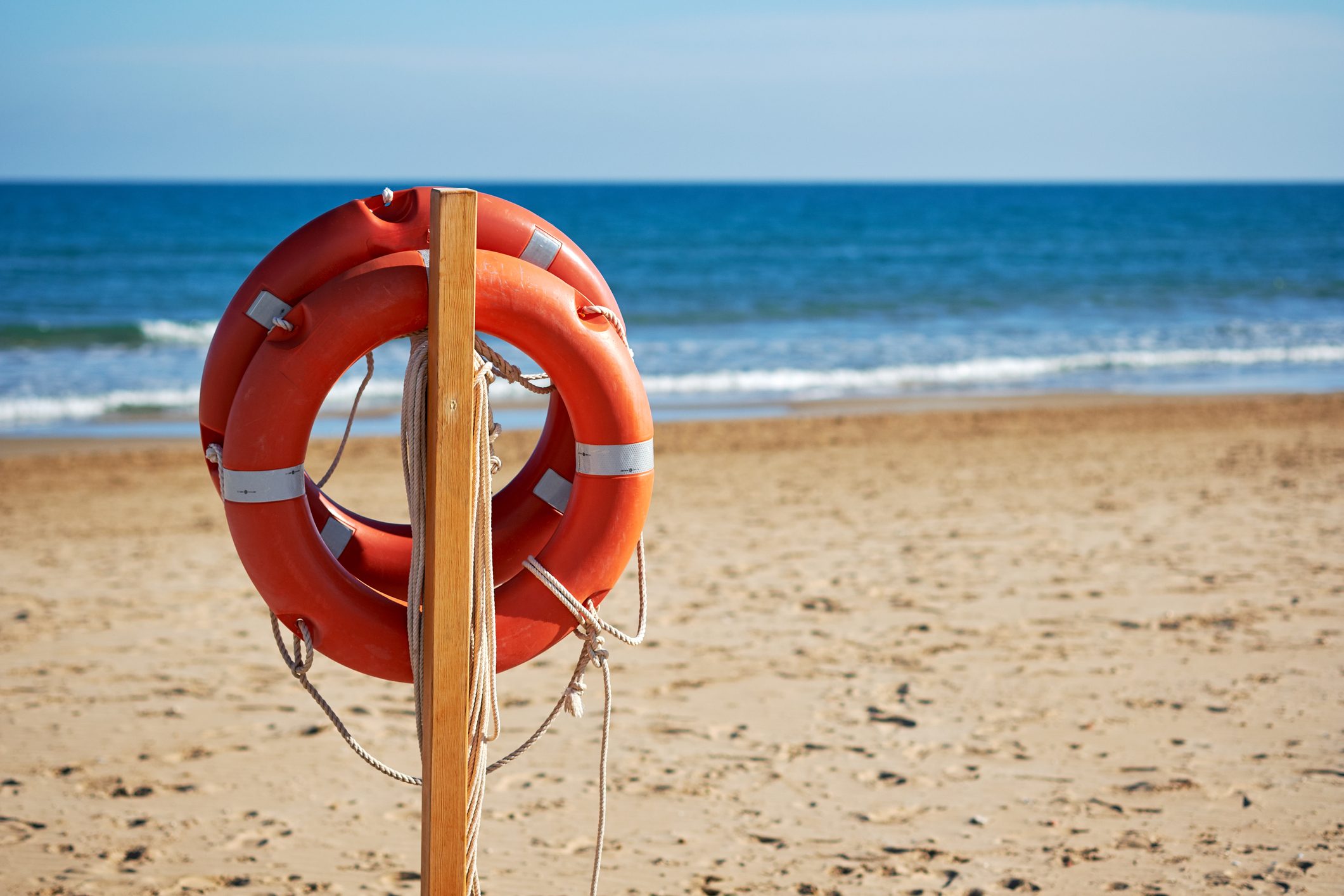
Stay safe in summer
Summer is generally a low-key time. There’s fresh air and sunshine and it’s usually a time to relax. But from the dangers of sun exposure to perils at the beach (not to mention the added risk of this year’s Covid-19 pandemic), there are all sorts of hazards that you can face in the year’s warmest months. Here are some often overlooked health dangers in summer.
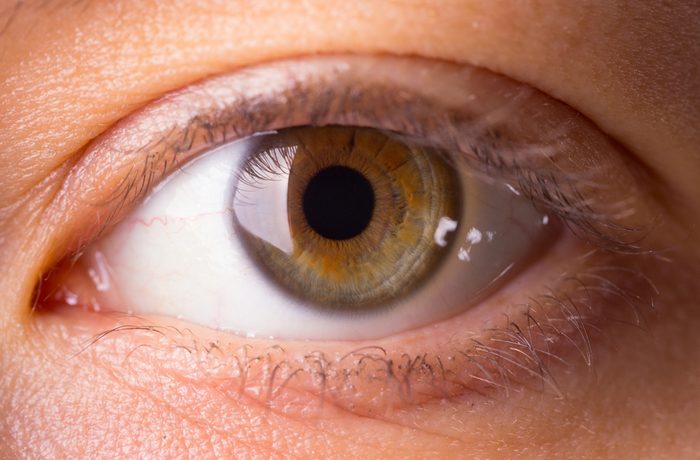
A sunburn on your eyeballs
Yes, you read that right. It’s called photokeratitis, and it can happen in just a few hours of exposure to strong, unblocked sun. If you don’t wear sunglasses regularly, you’re also putting yourself at an increased risk for cataracts, macular degeneration, and growths on your eye. According to the Vision Council, people are very lax about eye protection: A survey found that only 27 percent wear UV-protective sunglasses every time they go outside and just 49 percent wear them near a body of water. Because this type of damage is irreversible, it’s important to wear sunglasses with UVA and UVB protection to avoid a problem that’s a lot bigger than crow’s feet. (Check out these simple habits that protect your eyes over the summer and all year long.)

E. coli at your local beach
We’ve all heard about E. coli popping up in summertime food…but in the sand on the beach or around a lake? In a 2015 study published in Environmental Science and Technology, researchers at the University of Hawaii found that being exposed to fecal contamination and its associated bacteria on even the most beautiful sandy shore is a real risk. They found that fecal bacterial levels in the sand were 10 to 100 times higher than in the surrounding water. This may be because bacteria decay at a slower rate in the sand than in seawater, so the bugs accumulate in “biofilms” and in areas that the sun can’t reach. To avoid potential infection, make sure to cover any cuts and also wash your hands frequently. (Here are other ways to stay safe at the shore.)
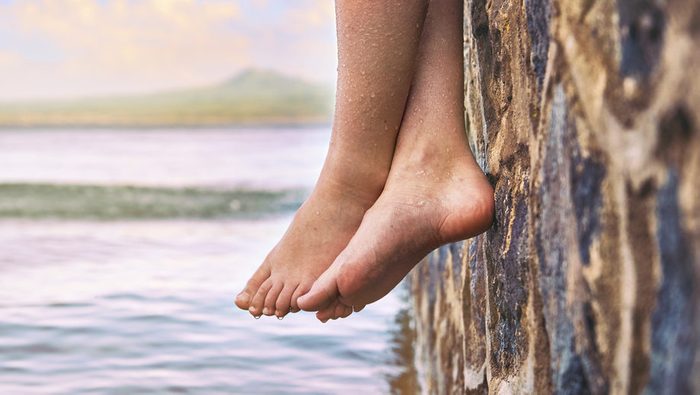
Brain-eating amoebas
Think you’re safe from being eaten alive because you’re not heading into shark-infested seas? Think again. Meet the Naegleria fowleri, also delightfully known as the brain-eating amoeba. It loves warm freshwater sources, such as lakes, rivers, and hot springs. According to the Centers for Disease Control and Prevention (CDC), infections most often occur from July through September. The southern states are the most at risk, with about half of cases popping up in Texas and Florida. Limit possible exposure by keeping your head above water when swimming and avoiding stirring up sediment on the ground.

Carcinogens from your BBQ
Nothing says “summer” like a backyard barbecue. But the old-fashioned way of grilling over an open flame can create two carcinogens—heterocyclic amine (HCA) and polycyclic aromatic hydrocarbons (PAHs). According to the National Cancer Institute, studies have found that regularly eating barbecued, well-done, or fried meat is associated with increased risks of pancreatic cancer. There have been mixed results on whether there’s a link between those meats and colorectal and prostate cancer.
To reduce these risks, use a vinegar-based marinade to act as a barrier between your meat and carcinogens. Try cutting back on grill time by precooking meat for a few minutes in the microwave first. (Here are other things that diabetics should watch out for this summer.)
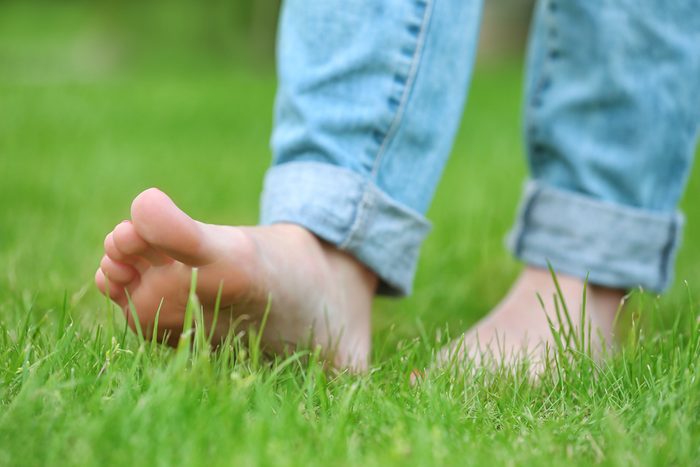
Walking barefoot in the park (or anywhere else)
There’s nothing like feeling the grass on your feet…until you accidentally step on something sharp. Puncture wounds are common in summer, and stepping on a rusty nail or another sharp object will require a tetanus shot within 48 hours if you haven’t had one in the past five years.
For people with diabetes and other nerve damage to the feet, things could be even worse: “If they step on something sharp that breaks the skin without feeling it, that injury could introduce an infection that threatens the viability of their toes, foot, or even lower leg,” says Pat Salber, MD, a board-certified internist and emergency physician and the founder of the website The Doctor Weighs In. “If you have a foot neuropathy, never go barefoot, and wear shoes with firm soles. It is far better than risking amputation due to an infection related to a ‘silent’ injury.” (Find out if walking barefoot is bad for your feet.)
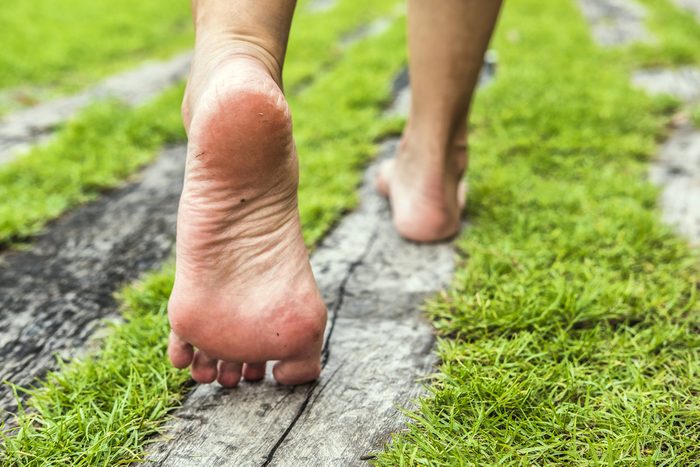
Creeping eruptions
Stepping in poop with your bare feet can be even more disgusting than you think. If you come into contact with hookworm-infested animal excrement, you can develop a something called a creeping eruption, which causes an itchy, threadlike rash. Children are more at risk for this than adults since they tend to go barefoot outside more frequently and venture into places adults would stay away from. A course of antiparasitic medication will clear things up—but get to the doctor fast since it spreads quickly.
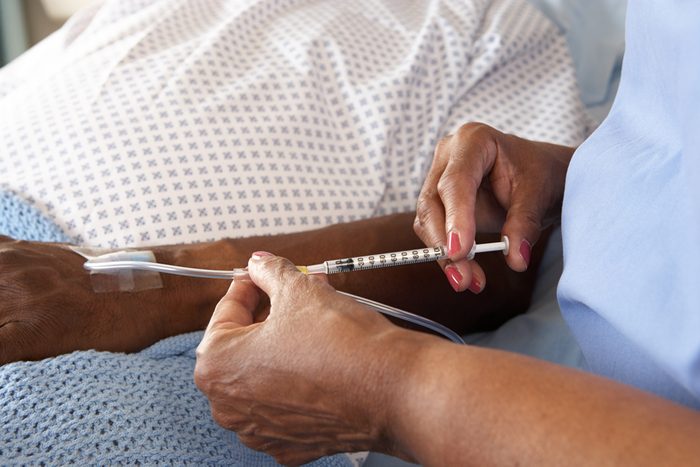
The “July effect” in hospitals
This one has nothing to do with the sun, sand, or surf, but it’s a summer health danger. The “July effect” is based on the idea that new residents start every summer in hospitals in July. Research published in 2007 in the Annals of Surgery found that patients in July and August had a 41 percent greater chance of dying in surgery than patients did in April and May.
July is when new doctors-in-training start their residencies and, as a result, are more apt to make mistakes—namely when it comes to prescribing and administering medication. Some hospitals notably take steps to combat this notion, pairing new residents with seasoned doctors to point out any mistakes.
In any case, be a strong advocate for yourself, enlist a family member or friend to help, and never be afraid to speak up if something seems off. (Here are other secrets hospitals don’t want to tell you.)
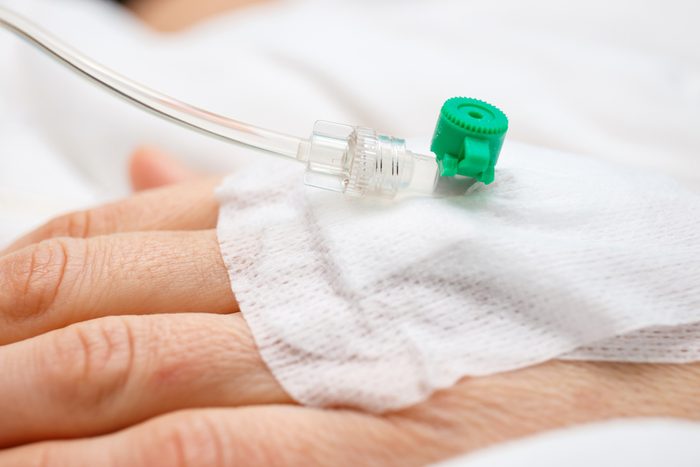
Post-surgery infections
Even if your doctors are top-notch and your surgery goes well, you’re at an increased risk for surgical site infections in the summer months. According to 2017 research published in Infection Control & Hospital Epidemiology, when the thermometer rises above 90 degrees Fahrenheit, a patient’s odds of being hospitalized for this post-op complication rises by 28.9 percent compared to when temperatures are under 40 degrees. While patients should always be vigilant about wound care, they should be especially aware that this could be an issue in the warmer weather and seek medical attention at the first sign of a possible infection.

Going down a slide with your child
Young toddlers at great heights are enough to give you heart palpitations, but resist the urge to climb up there and slide down with them. Why? Because your little one might end up with a broken leg. The American Academy of Pediatrics gathered information from ERs nationwide from 2002 to 2015 and found that 352,698 kids under 6 years old were injured on slides and more than one-third of those injuries were lower-leg fractures. In those cases, the child’s leg likely got caught between the parent’s leg and the edge of the slide with the adult’s added weight making them go faster and twist the leg dangerously.
The researchers suggest that parents let children ride slides solo. If you still want to do some tandem-sliding, use extreme caution to keep your little one’s extremities secure and away from the slide’s sides.

Deadly heat-related illnesses
If you dismiss the early signs of heat exhaustion and heat stroke as the normal effects of a hot day, you could be putting your life on the line. The CDC estimates that extreme heat kills more than 600 people in the United States every year. Warning signs you shouldn’t ignore include dizziness, headache, nausea, fatigue, and sweating. When your body temperature goes over 103 degrees with heat stroke, you will actually stop sweating and your skin will become hot, red, and dry, says the CDC.
Certain medications could make you more vulnerable to the heat, including blood pressure and heart medications, diuretics, medication for Parkinson’s disease, and seizure medications. Be safe by staying cool, staying hydrated, and listening to your body.

Driving without sunscreen
Getting behind the wheel without protecting your skin can be just as hazardous as baking on the beach. According to the Skin Cancer Foundation, Americans incur more photodamage on the left sides of their faces—aka the driver’s side—than the right. Glass blocks UVB rays and windshields are specially treated to block UVA rays, but side and rear windows still let UVA through. That’s why it’s essential to wear sunscreen every day, without fail. “Both UVA and UVB rays contribute to the development of skin cancer, but because UVA penetrates deeper, it is the larger contributor to wrinkles and sagging skin,” says Anne Chapas, MD, the founder and medical director of Union Square Laser Dermatology. “Also don’t forget reflection off water and sidewalks. Patients are always encountering potential UV damage even when they don’t realize it.”

Poison ivy, oak, and sumac
These itch-inducing plants have been around forever, but in recent years, they’ve become stronger and more populous. This may be a result of warmer temperatures and rising carbon dioxide levels due to climate change. To protect yourself, know what these problematic plants look like: Poison ivy and oak often have branches with three leaves, while poison sumac can have clusters of seven to 13 leaves, as well as black spots that look like paint splatters. And if you’ve touched them? The U.S. Forest Service suggests cleaning the affected area with rubbing alcohol within 10 minutes, as well as washing any clothes or tools that have come in contact with them since the plants’ urushiol oil can stay on surfaces. (Check out these poison-ivy treatments you’ll be thankful to know.)

Wild parsnip
It sounds innocuous enough, but this plant with yellow flowers that resemble wildflowers or celery leaves can cause serious damage to your body, reports the Iowa State University Extension. Wild parsnip contains something called psoralen, and when touched and exposed to sunlight, it can cause a rash, blisters, and burning, scalding pain. Even when the blisters heal, dark red or brownish discoloration in those spots can linger for months. You’re most likely to encounter these problematic plants between May and July.

Hogweed
Beware of pretty plants. Hogweed, which can grow up to 14 feet tall, is another poisonous plant you should have on your radar, especially if you live in New England, the Northwest, and the Mid-Atlantic. With delicate white flowers and green stems sporting red or purple spots, hogweed can cause burning, blistering, and long-term photosensitivity, similar to what happens with wild parsnip—but it could be so severe that it might necessitate a skin graft. Plus, if hogweed’s sap gets into your eyes, it could cause blindness.
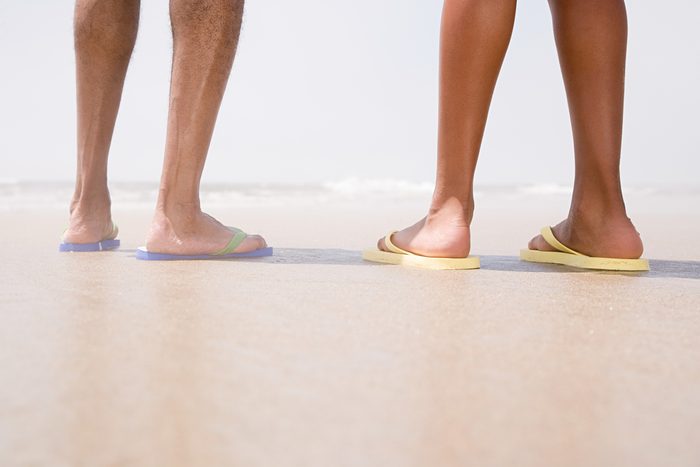
Wearing flip-flops
The ubiquitous summer sandal should come with a warning label. No matter how convenient they are, flip-flops can be bad for your feet, joints, and muscles. Since they usually don’t have any arch support, they can change the way you walk, causing you to take shorter steps and putting more stress on your body. People who are overweight are at an increased risk of developing health problems, including the painful foot condition plantar fasciitis. And the risks extend beyond your own body. They can make you more likely to have a car accident because they can slide or get stuck under the pedal, making it difficult to break quickly and efficiently. (Instead, here are the best summer shoes, according to podiatrists.)
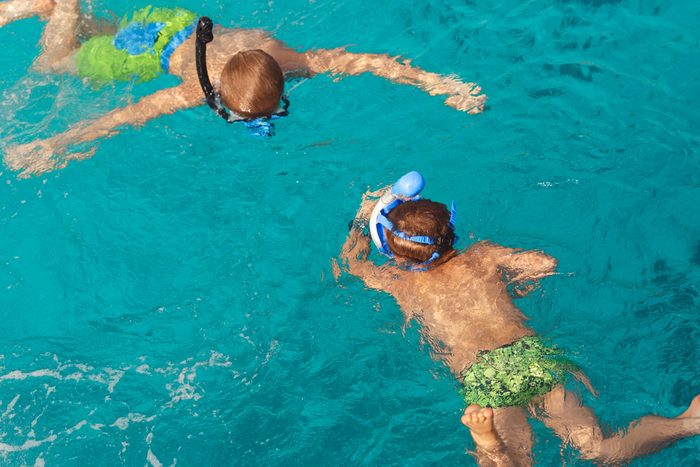
Drowning
While drowning can occur year-round, it only makes sense that it’s more common when people frequent pools and beaches. According to the CDC, around 4,000 people in the United States drown each year, and the biggest at-risk group is children under 5. Alcohol is often a factor in fatalities involving adolescents and adults. So, adults: Stay sober to stay safe, and make sure that older kids know the risks of drinking while near water. As for younger children, Dr. Salber says, “Home pools should have childproof fencing to avoid accidental drownings, and children should be taught to respect the dangers of unguarded bodies of water.” Teach them to swim, make sure they wear inflatables if they can’t swim well, and always keep a close eye on them. Remember: People often don’t splash and scream when they go under, so vigilance is key.

Rip currents
Sometimes mistakenly called riptides or undertow, rip currents are very strong currents of water that can be 2,500 feet long but are typically no wider than 30 feet. These strong, channelized currents don’t technically pull people under water, but they can carry even very strong swimmers away from shore. Every year, rip currents claim the lives of more than 100 people. At that point, people tend to panic and their risk of drowning increases.
So, how can you identify and avoid a rip current? Beware of calm patches of water between intense breaking waves, especially at low tide, when the water is already moving out. If you do get caught in a rip current, don’t swim against it; that will tire you out and get you nowhere. Instead, experts recommend swimming sideways out of the current or even just treading water until you’re released from it. (Check out these water safety tips lifeguards wish you knew.)
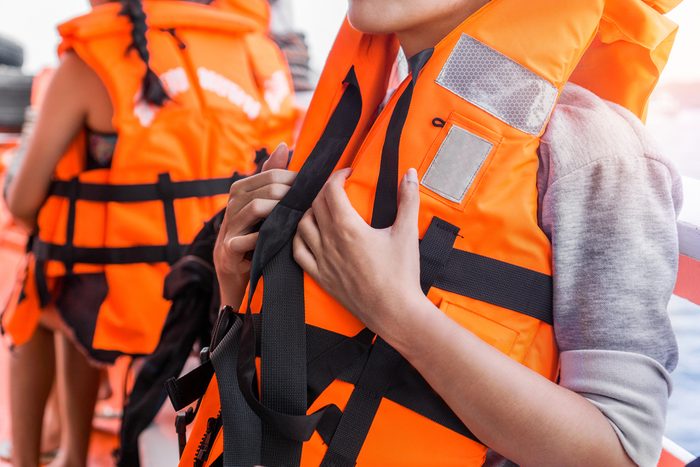
Poor judgment while boating
Always wear a life jacket, says the U.S. Coast Guard: 79 percent of boating accidents involved drowning, and of that number, 86 percent of victims weren’t wearing a life jacket. Also, make sure that your boat driver is experienced. More than 70 percent of fatalities happened on boats on which the operator wasn’t certified in boating safety.
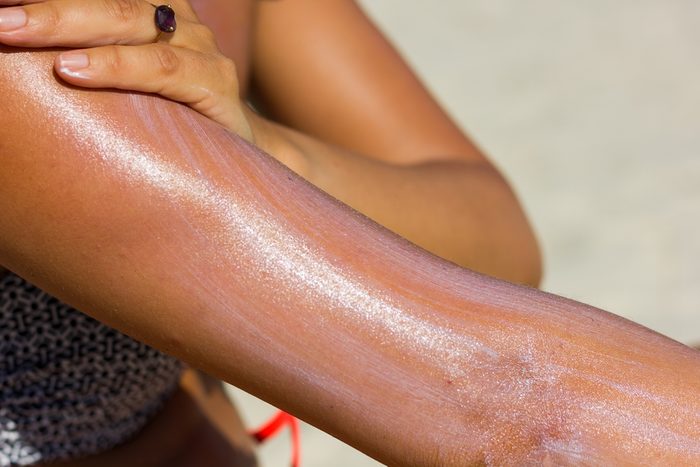
Sunburns on cloudy days
It’s easy to forget to slather on the sunscreen when there’s not a ray of sunshine in sight, but that’s when you may need it the most. About 80 percent of the sun’s UV rays can pass through clouds and to your unprotected skin. And when it’s cloudy, hazy or cool, you’re more likely not only to forget your SPF—you’re also more likely to stay outside unprotected for longer. Also, sand and water can reflect UV rays and can burn your skin. (Check out these other surprising things that could cause a sunburn.)
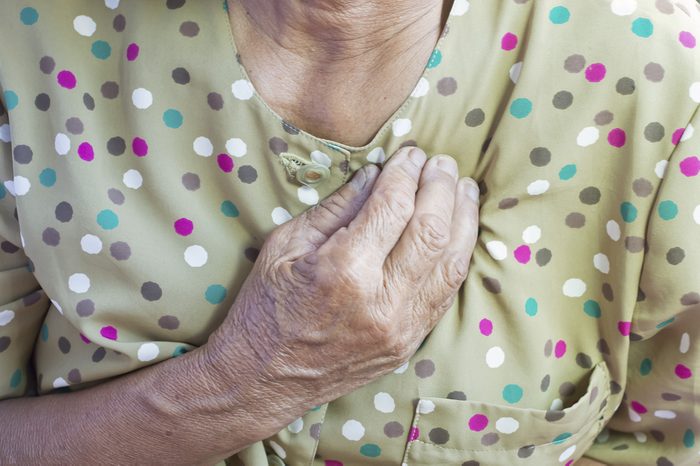
Your heart health
Science suggests that you’re more likely to have a heart attack in the winter months, but that doesn’t mean you’re in the clear during the hot, hazy days of summer. Matthew Mintz, MD, a Bethesda, Maryland-based primary-care physician and internist, says that normal summer temperatures shouldn’t increase a person’s risk of heart attack but that things can get complicated for those who take blood pressure or other heart medications. “When the temperature goes up, the body keeps itself cool by increasing blood flow to the skin to ‘let off some steam,'” he explains. “However, blood pressure medications can block some of the body’s normal responses to heat and can increase the risk of heat stroke and/or dehydration.” As a result, those people should be particularly careful about staying cool and hydrated.

Alcohol-related dehydration
That poolside cocktail might be refreshing and relaxing, but you should think twice before ordering another round. That’s because, as Dr. Mintz explains, “alcohol is a diuretic, meaning it makes you urinate more, so even though you’re drinking a beverage, you can lose more fluid than you take in.” While he says that a few drinks alone likely won’t cause dehydration, they can contribute to or accelerate it. Plus, as he mentions above, blood-pressure medications can pose an added risk: “A 60-year-old man who is otherwise healthy but on blood-pressure or cholesterol medicine might have a beer or two by the pool on a hot, sunny day and get lightheaded, dizzy, or pass out without much warning.” (Check out these tricks to cool down in the summer.)
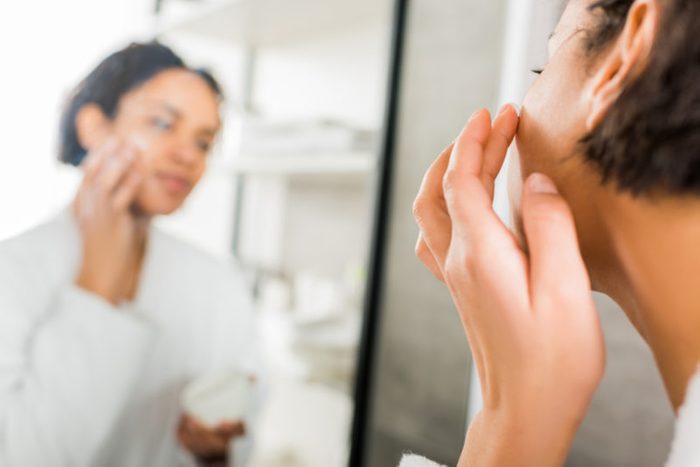
Skimping on sunscreen
People who diligently apply sunscreen every morning think they’re safe, but their false sense of security can put them at risk. So what is the magical amount? According to Y. Claire Chang, MD, of Union Square Laser Dermatology, people should apply 1 ounce (about the size of a shot glass) of a broad-spectrum sunscreen with SPF 30 or higher—every two hours. “Reapplication is just as important as applying it in the morning,” she says. Plus, women shouldn’t fall into the trap of thinking that their SPF-infused makeup provides enough protection all day. “Many makeups only have SPF 15,” Dr. Chang adds, “and most people do not apply a thick enough coat to allow for full protection.” So, sunscreen first, makeup second, and reapplication third if you’re going to be outside for an extended period of time. (Here are some sunscreen myths that make dermatologists cringe.)

Gestational diabetes
Most moms-to-be know that they should keep their weight and junk-food intake in check to help prevent gestational diabetes, but something as seemingly innocuous as being pregnant in the summer can increase their chance of developing it. A Toronto-based study published in the Canadian Medical Association Journal found that with every 10-degree Celsius rise (50 degrees Fahrenheit), a pregnant woman’s risk goes up by 6 to 9 percent. They theorize that the body’s subcutaneous brown fat, which heats you up when it’s cold out, helps the body regulate sugar levels and, therefore, offers protection against diabetes. It apparently does less of that when it’s hotter out. Of course, it’s also good to be active when pregnant, but make sure not to get overheated and to stay in air conditioning when possible.
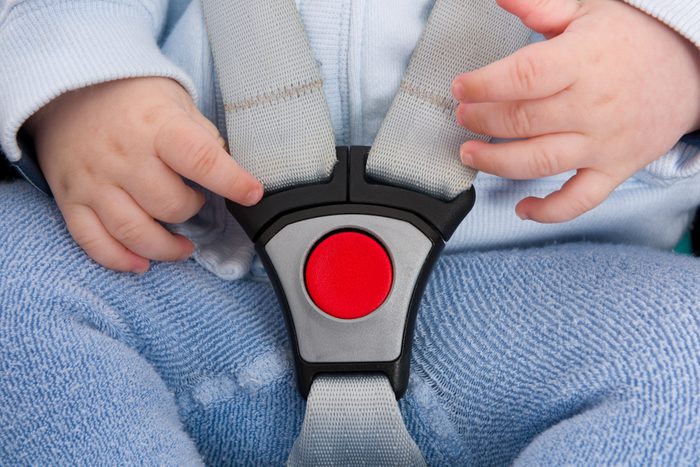
Heat-related car-seat deaths
Each year, more than 30 children die from the heat after being forgotten in a car, according to the National Highway Traffic Safety Administration (NHTSA). Texas and Florida have the dubious distinction of being the states with the most deaths, but it can happen anywhere—and things can get deadly fast. A child’s body temperature rises as much as five times faster than an adult’s, according to the NHTSA. When a child is forgotten in a hot car, their temperature can rise so fast, they could die within a few minutes. So always check the backseat before exiting your car, and think about leaving your purse or cell phone back there to help you remember. (Here are the products you should avoid using on your baby.)

Spoiled food
While we all know that we shouldn’t leave food in the heat for too long, we still forget to keep a close eye on the clock at a party or picnic. There are some surprising foods that can give you food poisoning. According to the FDA, food shouldn’t stay in the so-called danger zone—between 40 and 140 degrees Fahrenheit—for more than two hours. That number gets knocked down to just one hour if the mercury rises above 90. That’s when bacteria, mold, and yeast start forming on your food and release waste products and toxins. (Here are rules that will help you avoid food poisoning.)

Undercooked, contaminated, and otherwise dangerous food
Approximately 128,000 people in the United States are hospitalized after contracting a food-borne illness every year, and the most fatalities result from salmonella, toxoplasma, listeria, and norovirus, according to the CDC. Problems can occur when food such as hamburgers and chicken aren’t thoroughly cooked, when raw shellfish is contaminated with certain bacteria, and when vegetables and leafy greens aren’t washed properly.

Shark attacks close to the shore
Experts say that shark attacks are rare (and the statistics confirm that), but no one wants to end up as a snack for one of the world’s most terrifying predators. According to the National Ocean Service, attacks are more prevalent near the shore, usually in front of a sandbar or between sandbars, where sharks can get trapped by low tide, and near steep drop-offs, where shark prey congregates. Be smart in the water by staying in groups, by swimming during the day, and by ditching brightly colored bathing suits and shiny jewelry, which can apparently attract the wrong kind of dorsal-finned attention.

Drinking while boating
Drinking and driving don’t mix—and goes for boats as well as cars. According to statistics from the Coast Guard, there were 4,463 boating accidents, 701 deaths, 2,903 injuries, and $49 million of property damage in 2016. Alcohol was the biggest contributing factor in accidents with fatalities. (Here are tips to help you cut back on alcohol.)
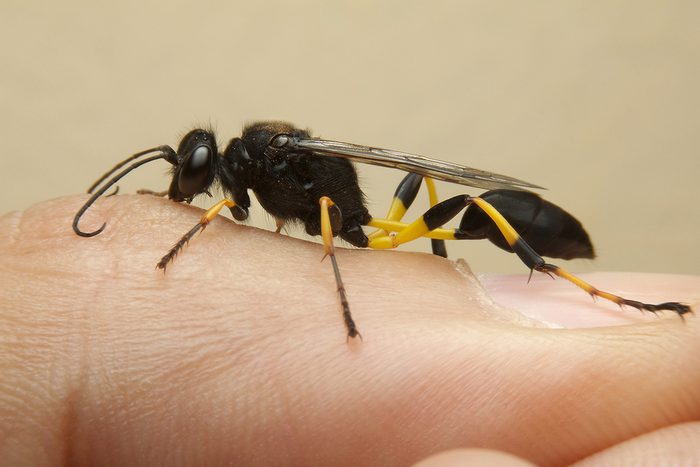
Things that sting
More time outside means more risk of summertime stings. The problem is that many people don’t know they’re allergic to a bee or wasp sting until after they’ve been stung, and sometimes it takes a number of stings to trigger a full-blown allergic reaction. If the pain of a sting is accompanied by hives, chest tightness, difficulty breathing, swelling of the tongue, or dizziness, see a doctor immediately. (Here’s the best way to treat every kind of bug bite.)

Dry drowning
Dry drowning often affects children. It happens when people think they’re in the clear, after a near-drowning scare. It occurs when inhaled water makes the vocal cords swell and closes off the airway. And then there’s the similar secondary drowning, during which water enters the lungs, causing fluid build-up and possibly pulmonary edema. While rare (1 to 2 percent of drownings), both dry and secondary drowning can be fatal if not caught early. The signs to look out for are a persistent cough, trouble breathing, mental confusion, and lethargy. If your child is exhibiting any of these symptoms or just seems “off” after an incident, head to the ER immediately.

Grilling injuries
Barbecuing is a summer staple, but it’s one that requires more safety know-how than just firing up the grill and slapping on some hamburgers. According to the National Fire Protection Association, between 2014 and 2018, there was an average of 10,600 home fires that started with a grill, hibachi, or barbecue. This resulted in an annual average of 10 deaths, 160 injuries, and $149 million in property damage. Five out of six of the culprits were gas grills. To avoid a similarly devastating situation, make sure to clean equipment properly, keep it away from things that could catch fire, and never leave it unattended when it’s on. (Need more tips? Here’s how you’re using your grill wrong.)
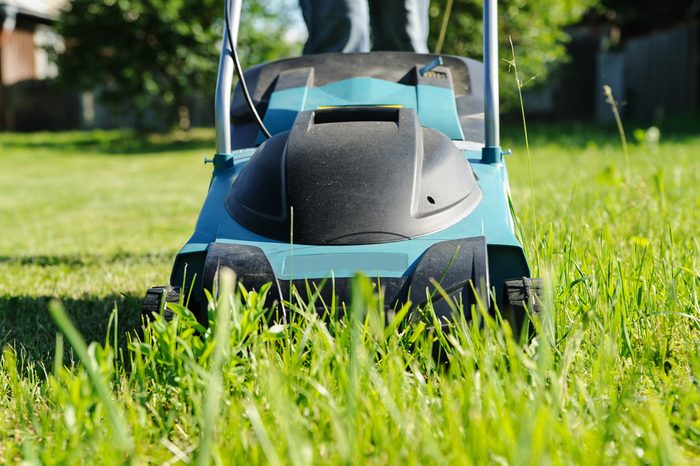
Lawn mower accidents
Approximately 80,000 people in the United States head to the hospital every year for lawn mower accidents, according to a 2006 report in the Annals of Emergency Medicine. Fortunately, the injuries aren’t always as gruesome as you might think. The majority of them happen when a mower accidentally runs over an object like a rock or a stick and the mower blades inadvertently send it hurtling in your direction. Take particular care to clear the yard of debris before mowing, and make sure to mow in full daylight. It’s also a good idea to wear sunglasses, long pants, long sleeves, and closed-toe shoes for protection.
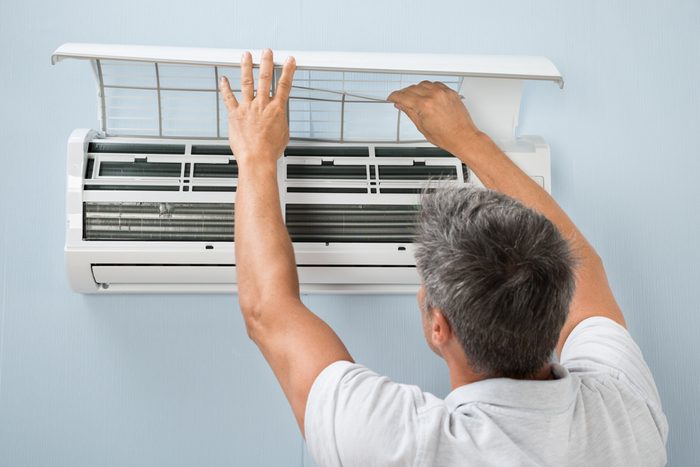
Hidden air-conditioner mold
You might not see it, but that doesn’t mean it’s not there and causing a potentially big problem. Dust, mold, allergens, and pollution accumulate on air-conditioning-unit filters, complicating things for people whose lung health is already compromised. Who might that be? Those with allergies, asthma, or other respiratory diseases. It’s nearly impossible to clean a unit once mold is present, so you may have to replace it with a new unit, says Lara Adler, an environmental toxins expert and certified holistic health coach in Portland, Oregon. If you have a central HVAC system, make sure to maintain it regularly. (Here are other surprising ways your house might be making you sick.)
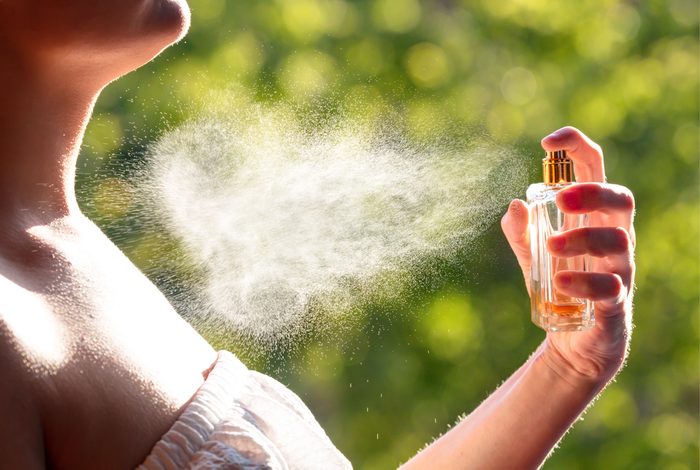
Sunburn from perfumes and other fragrances
Perfumes and certain fragrances can make your skin more sensitive to the sun and, as a result, increase your risk of sunburn. Fragrances with ingredients like cedar, rosemary, sandalwood, lavender, and bergamot, can contain chemicals that affect the skin, says Sonia Batra, MD, board-certified dermatologist and co-host of The Doctors. It’s probably a good idea to forgo the scents if you plan to be in the summer sun.

Urinary tract infections
A urinary tract infection is annoying in any season, but you have a higher likelihood of developing one in the summer when the heat and humidity increase and you’re more likely to be dehydrated, according to the Urology Care Foundation. So take particular care to stay hydrated, which will dilute urine and flush out bacteria, and always use the bathroom shortly after having sex. UTI symptoms include the need to go to the bathroom often, cloudy, smelly urine, and painful, burning sensation when you go.
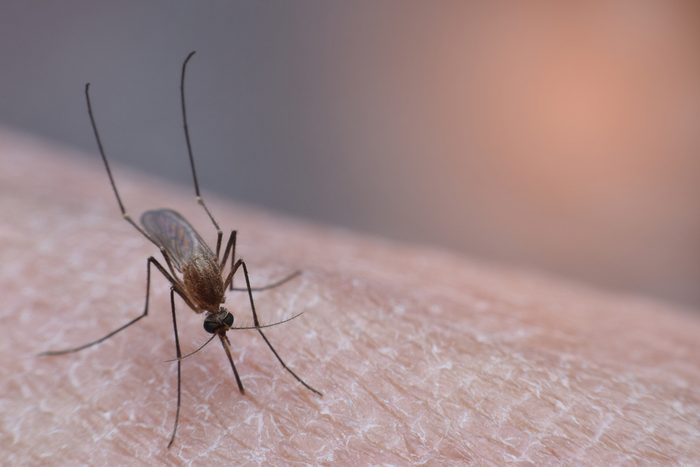
Zika, West Nile, and other infections carried by mosquitoes
Mosquitoes are responsible for spreading many dangerous diseases including West Nile virus, which can cause debilitating muscle weakness and encephalitis, as well as Zika, which can cause birth defects during pregnancy. That’s why it’s so important to protect yourself against mosquitoes. Dr. Salber advises avoiding exposure when possible: “I am not saying you should never venture into nature. Rather, you should take precautions, like avoiding being outside uncovered during periods when mosquitoes are most active, covering up with long-sleeved shirts and pants, and using a high-quality insect repellent.” (For added protection, check out these foods that can protect you against bug bites.)
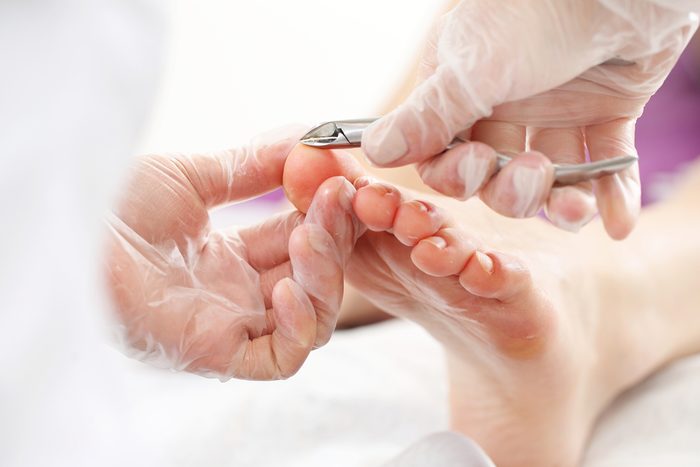
Post-pedicure infections
That pretty pedicure can get pretty disgusting pretty quickly—and it has nothing to do with going too long between appointments. Fungal infections occur more frequently when it’s warm out, according to Yale Medicine, and they can be difficult to treat. Medication works only 50 percent of the time, and a new nail could take more than a year to regrow. That’s why it’s so important not to leave yourself vulnerable to infection. Make sure to go to a reputable nail salon, bring your own tools, and clean them properly with warm, soapy water before sterilizing them with rubbing alcohol. (Learn more about pedicure dangers that could actually land you in the ER.)
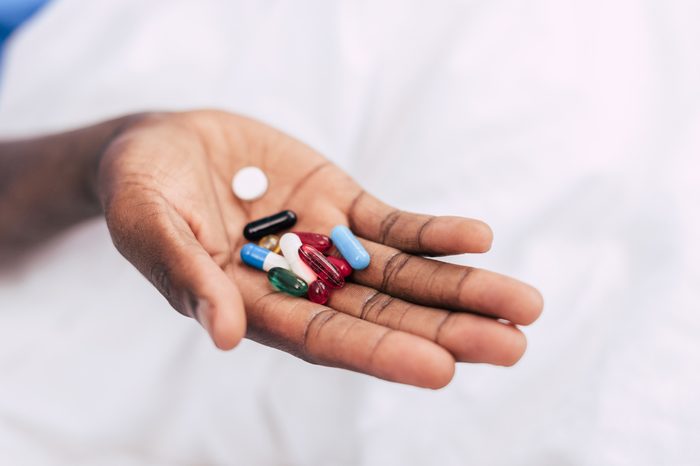
Your daily medications
Sunscreen isn’t enough to protect you from the summer sun when you’re taking certain medications that prime you for a burn from the inside out. “There are phototoxic and photoallergic reactions that occur when the drug is distributed throughout the body and then exposed to UV light,” explains Dr. Chapas. “The biggest offenders we see in dermatology are topical tretinoin and oral doxycycline, but there are tons of drugs that can cause this reaction.” To avoid this problem, talk to your doctor about the risks and potential side effects of your prescriptions. Dr. Chapas usually advises patients to stop non-essential medications, like ones for acne, if they’re taking a beach vacation or will otherwise be in the sun for prolonged periods of time.
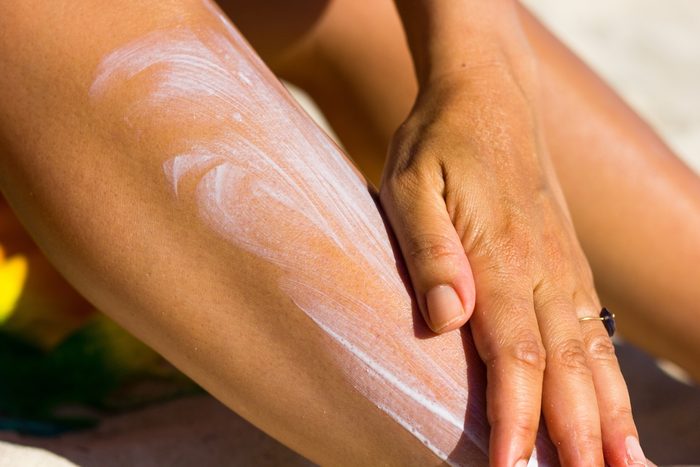
Forgetting to put sunscreen on these spots
When applying sunscreen, the obvious spots are, well, obvious. But there are other equally vulnerable areas that are regularly exposed to the sun, and when you overlook them, you increase your odds of developing skin cancer. Dr. Chapas says that men often forget to protect their scalps and ears. Aside from applying sunscreen, she recommends wearing a large-brimmed hat for protection. And for women? “Women tend to develop skin cancers on their legs,” she says. “They need to be vigilant about applying sunscreen and not tanning their legs while the rest of their body is under the umbrella.” Other at-risk spots: lips, the neck, and the chest. (Here are other ways to cut your cancer risk.)
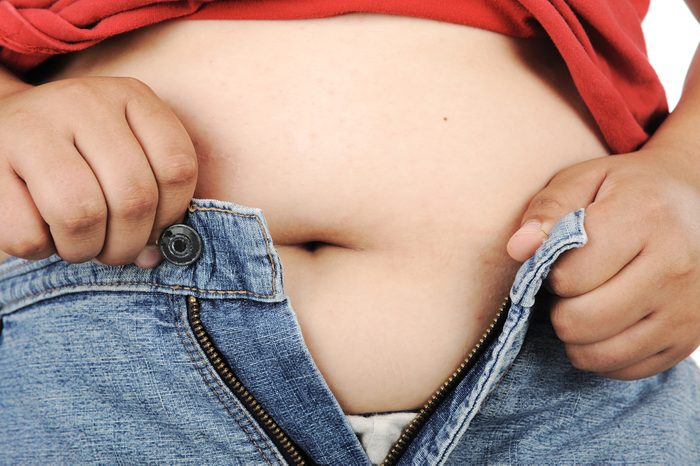
Weight gain in children
Idle minds lead to idle hands—which may end up reaching into a cookie jar. A 2016 study in the journal Obesity found that kids are at an increased risk for weight gain and childhood obesity during their two months off from school. Researchers looked at the data from children in kindergarten through second grade and saw that obesity rates jumped from 8.9 to 11.5 percent; the prevalence of being overweight also went from 23.3 to 28.7 percent. Researchers point to irregular sleep schedules in summer for a possible cause, as well as an increase in screen time. So, try not to let those summer days be all that lazy: Keep kids active and on a schedule. (Check out things parents can do to prevent summer weight gain in kids.)

Lightning
Lightning might not strike in the same spot twice, but it strikes more often than you think. Lightning strikes kill about 20 people each year, according to the National Oceanic and Atmospheric Administration. Between 2006 and 2019, 418 people died after being hit by lightning in the United States and 70 percent of the deaths occurred in June, July, and August. Many of the fatalities occurred while boating, fishing, or while on the beach. It’s also why you should never shower during a thunderstorm.
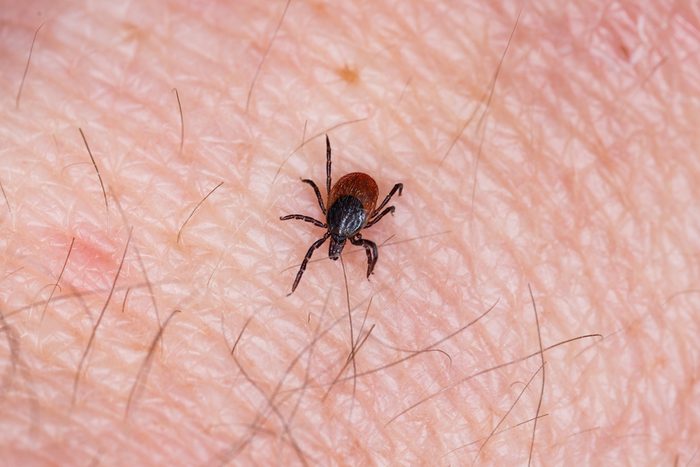
Tiny ticks carrying Lyme disease
In recent years, Lyme disease has soared, especially in the Northeast, the Mid-Atlantic, and part of the Upper Midwest. Around 30,000 cases are reported annually, though the actual number may be closer to 300,000, according to the CDC. The early symptoms of Lyme disease—which can damage joints, the heart, and the brain—are fever, headache, fatigue, muscle, and joint pain, as well as a distinctive bull’s-eye rash around the site of the bite. Fortunately, “being treated early almost always leads to a complete recovery,” says Dr. Mintz, so do a full-body check on yourself and kids every day. Prevention is also important. “People should avoid wooded and brushy areas with high grass,” advises Dr. Mintz, “walk in the center of trails when hiking, and use bug repellent on exposed skin.”
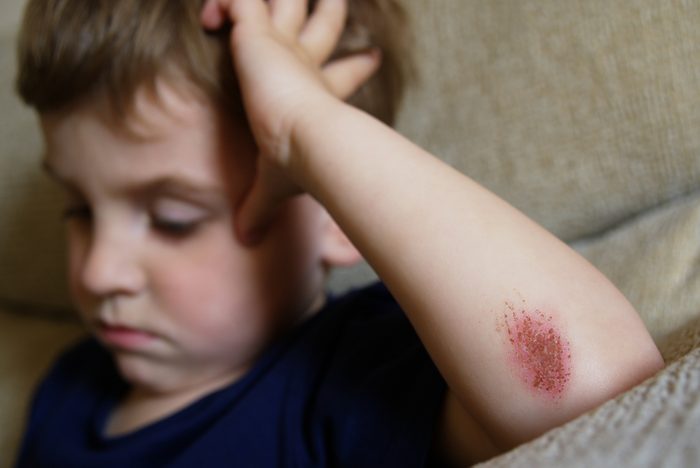
Antibiotic-resistant infections
Shorts season brings innumerable scuffs and scrapes for kids, but if you’re not careful, even the tiniest of cuts could pose a serious health hazard. Research from Johns Hopkins reveals that antibiotic-resistant staph infections (aka MRSA) affecting children spike during summer months. Plus, 74 percent of those under 20 who contract MRSA do so from a “community setting,” as opposed to a hospital. To protect kids with basic first aid, teach them about good hygiene, keep cuts covered with dry bandages, and don’t let them share towels or other items that contact bare skin. Also, see a doctor immediately if a wound becomes red, swollen, pus-filled, or red-streaked, as well as if it is accompanied by a fever.
Next, don’t miss these healthy ways to prepare your body for summer.